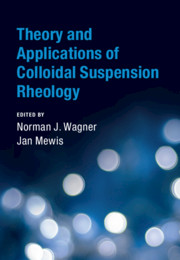Book contents
- Theory and Applications of Colloidal Suspension Rheology
- Cambridge Series in Chemical Engineering
- Theory and Applications of Colloidal Suspension Rheology
- Copyright page
- Dedication
- Contents
- Contributors
- Preface
- General List of Symbols
- Useful Physical Constants and Values
- 1 Introduction to Colloidal Suspension Rheology
- 2 Theory of Colloidal Suspension Structure, Dynamics, and Rheology
- 3 Methods of Colloidal Simulation
- 4 Microstructure under Flow
- 5 Rheology of Colloidal Glasses and Gels
- 6 Suspensions of Soft Colloidal Particles
- 7 Biocolloid Rheology
- 8 Hemorheology
- 9 Applications
- Index
- References
3 - Methods of Colloidal Simulation
Published online by Cambridge University Press: 07 April 2021
- Theory and Applications of Colloidal Suspension Rheology
- Cambridge Series in Chemical Engineering
- Theory and Applications of Colloidal Suspension Rheology
- Copyright page
- Dedication
- Contents
- Contributors
- Preface
- General List of Symbols
- Useful Physical Constants and Values
- 1 Introduction to Colloidal Suspension Rheology
- 2 Theory of Colloidal Suspension Structure, Dynamics, and Rheology
- 3 Methods of Colloidal Simulation
- 4 Microstructure under Flow
- 5 Rheology of Colloidal Glasses and Gels
- 6 Suspensions of Soft Colloidal Particles
- 7 Biocolloid Rheology
- 8 Hemorheology
- 9 Applications
- Index
- References
Summary
Methods to simulate colloid suspension structure, dynamics, and rheology are presented and distinguished by whether the solvent is modeled by a continuum or by meso-scale particles, and whether or not a mesh is used. The unmeshed/continuum solvent methods include various forms of Stokesian Dynamics, while the meshed continuum solvent methods include the Arbitrary Lagrangian–Eulerian method and the Immersed Boundary Method. Mesoscopic particles are used on a mesh in the Lattice–Boltzmann (LB) method and are mesh-free in Dissipative Particle Dynamics (DPD). These and other methods are reviewed and guidance provided on which ones are preferred in various situations. For spherical hard particles at high concentrations, without inertia, when accurate treatment of hydrodynamic interactions is needed, versions of Stokesian dynamics set benchmarks for accuracy and efficiency. Other methods become preferable depending on the speed needed for computation, the numbers of particles to be simulated, how well hydrodynamic interactions need to be modeled, whether Brownian motion or particle inertia is important, the shapes and deformability of the particles, the complexity of the flow domain, and whether the solvent is non-Newtonian. Information in this chapter indicates how well the different methods perform in their present state of development.
- Type
- Chapter
- Information
- Theory and Applications of Colloidal Suspension Rheology , pp. 120 - 154Publisher: Cambridge University PressPrint publication year: 2021
References
- 2
- Cited by



